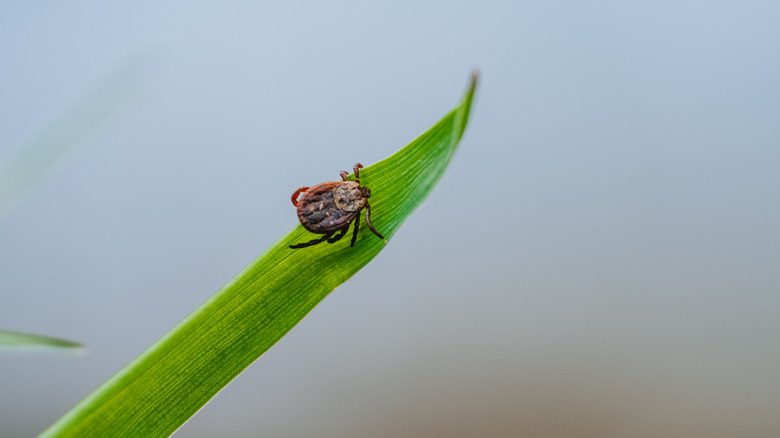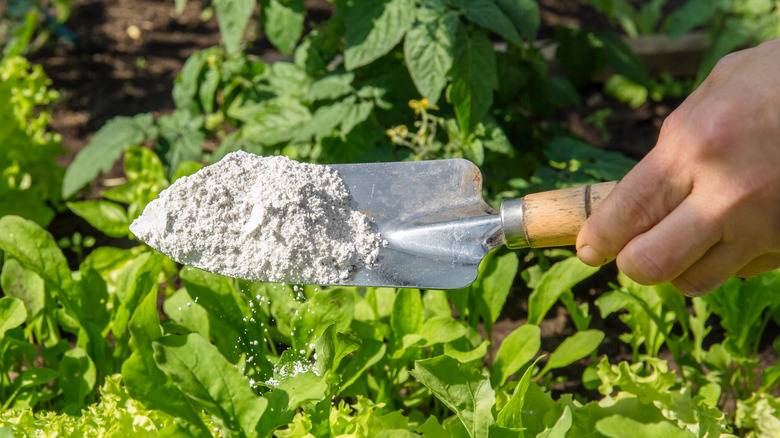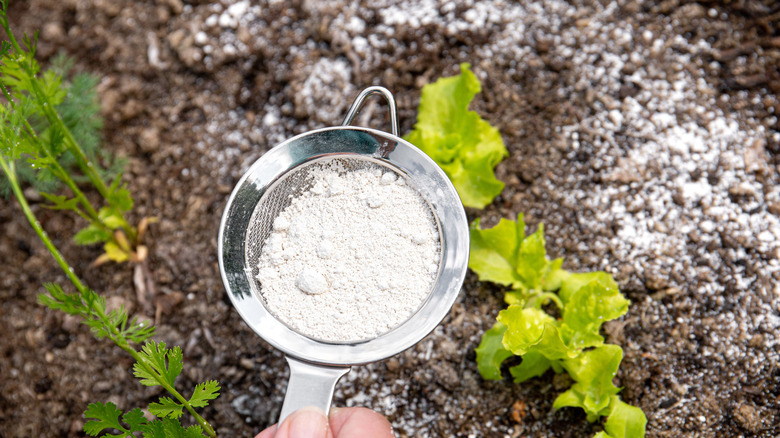The Simple Remedy You Need To Wipe Out Pesky Ticks Naturally
There are plenty of pests that homeowners don't enjoy finding in their yard, but ticks are one of the most dangerous. While they are often mistaken for insects, ticks are actually arachnids, sporting eight legs like a spider. They can be tough to spot because they are tiny, usually close in size to a sunflower or apple seed, and like to hang out in tall grass. Not all tick bites hurt, so you may not even realize you've been bitten until you find one on your skin. That doesn't mean they aren't cause for concern, though — these pests can spread several serious diseases to you, your children or your pets, including Lyme disease, Rocky Mountain spotted fever, and Colorado tick fever, so protecting yourself and your home from ticks should be a top priority in spring and summer.
The good news is that you don't need to use potentially toxic chemicals to prevent ticks from visiting your yard. Diatomaceous earth (DE) is one of the most effective all-natural tools for keeping these pests away. If used correctly, it is an eco-friendly alternative to store-bought repellents and doesn't require a heavy application to provide results.
How DE controls ticks
If you're wondering what diatomaceous earth is and how it works for tick control, the answer is actually pretty interesting. DE is made of diatoms, which are the fossilized skeletons of algae and other aquatic organisms that are ground into a fine powder. The powder itself is not toxic to ticks, so they don't need to consume it to die. Instead, it works by dehydrating the ticks. DE particles have sharp, rough edges that can cut into a tick's body. These abrasions allow the powder to penetrate the exoskeleton more easily, so it can absorb the oils, fats, and other body fluids from the ticks and completely dehydrate them until they die.
It's important to understand that DE doesn't repel ticks, though. It doesn't function as bait for trapping them, either. DE will kill pests that travel over it and get it stuck to their bodies, but the process isn't instantaneous. It can take hours or days for the ticks to die.
DE is available in two types: food-grade DE and industrial-grade DE. As its name implies, food-grade DE is safe for consumption, so it is non-toxic around children and pets, though it can still cause respiratory issues if inhaled. On the other hand, industrial-grade or filter-grade DE is typically used for pool filtration and pest control and toxic if ingested. If you want a safe, natural way to keep ticks at bay in your yard, only use food-grade DE to keep ticks out of your yard.
Using DE for tick control
Because ticks must come into contact with DE for it to be effective, apply it to areas in your yard where you suspect they are hiding, such as those with tall grass. DE only works when dry, so ensure that it hasn't rained in the days leading up to the application. Cover the areas with a light dusting of DE, as ticks and other pests often avoid thick layers. You should always wear gloves, protective eyewear, and a dust mask when applying DE, too, because it can cause skin irritation and respiratory issues if inhaled.
While DE is highly effective for tick control, you'll achieve the best results by pairing it with other methods. Keep your lawn closely cut, as ticks prefer tall vegetation. Also, clear your yard of fallen leaves, branches, and other debris where they might hide. It's a good idea to create a barrier around the perimeter of your yard, too — cedar mulch works as a natural tick repellent, and gravel or stone can dry them out before they reach your lawn. You can even add some plants that naturally repel ticks to your landscape.


